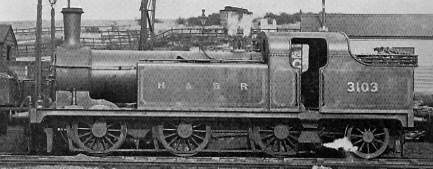The M.Stirling N12 (H&BR Class F2) 0-6-2T Locomotives

At the beginning of the 20th Century, the fortunes of the Hull & Barnsley Railway (H&BR) were improving and it found that it was very short of larger shunting locomotives. This problem was solved by the immediate purchase of the five N11 locomotives from Kitson, and by Matthew Stirling designing the N12 0-6-2T. A total of nine N12s (H&BR Class F2) were ordered from Kitson & Co, and all were delivered in November and December 1901. The N12 design included many features typical of Matthew Stirling including a domeless boiler and round cab.
In 1907 at Wath, No. 109 suffered a boiler explosion. An inquiry blamed the explosion on poor supervision of boilers and fireboxes. The boiler appears to have been repaired rather than replaced, because the age was quoted at 21 years when the North Eastern Railway (NER) took over.
All nine locomotives survived to Grouping (1923) with their original boilers. These were in need of replacement, and the H&BR had started to acquire materials to build a new set of boilers. The material was shipped to Darlington where it was used to build new domeless boilers for four N12s and one J75 0-6-0T. Doncaster provided an old boiler from a NER '901' class that was withdrawn in 1922. This domed boiler was fitted to No. 3104 in 1923. Darlington designed the new Diagram 71B domed boiler for fitting to the remaining four N12s. These were fitted in 1924-5, and were also used to re-boiler the N13s and the J75s. A couple of boiler swaps occurred during 1934. No. 2484 received a domeless boiler taken from a withdrawn N12, and No. 2487 received an ex-'901' class boiler that had also served on J80 No. 2449.
The N12s were concentrated at the coalfield end of the H&BR, and usually worked the Wath and Denaby branches from Cudworth shed. They also worked on the Braithwell Joint Line when it opened in 1916. Typical work involved short goods trains, banking, and assembling mineral trains on colliery sidings. Fitted with vacuum brakes, they also performed a small amount of passenger work on these branches.
After about 1926, the N12s tended to drift away from Cudworth. Allocations were varied and included Springhead shed, Dairycoates shed, farm traffic on the Derwent Valley Light Railway, Hartlepool, and Ferryhill. By 1936, N12s were also being seen further south, including Woodford, and Ardsley. During all these allocations, the N12s would be found working the same kinds of duties: shunting, and trip workings.
Withdrawals started in 1936, and only one N12 was left at the end of 1938. The sole survivor, No. 2486 was allocated to Ardsley until 1938 when it was moved to Tuxford to work as the wagon repair works' shunter. In 1942 it moved back to Springhead where it remained until withdrawal in August 1948. Just surviving into Nationalisation (1948), this locomotive was allocated the BR number 69089 but never actually received it.
Technical Details
| Cylinders (x2): | (inside) | 18x26in. |
| Motion: | Stephenson | slide valves |
| Boiler: | Max. Diameter: | 4ft 3in |
| Pressure: | 160psi | |
| Heating Surface: | Total: | 1055 sq.ft. |
| Firebox: | 107 sq.ft. | |
| Tubes: | 951 sq.ft. (194x 1.75in) | |
| Grate Area: | 16.25 sq.ft. | |
| Wheels: | Coupled: | 4ft 6in |
| Trailing: | 3ft 9in | |
| Tractive Effort: | (@ 85% boiler pressure) | 21,216lb |
| Total Wheelbase: | 23ft | |
| Engine Weight: | (full) | 58 tons |
| Max. Axle Load: | 16 tons 15cwt | |
| Coal Capacity: | 3 tons 0cwt | |
| Water Capacity: | 1558 gallons |
Preservation
The last N12 was withdrawn in 1948, and none survived into preservation.
Models
I am not aware of any models of the N12 in any scale.